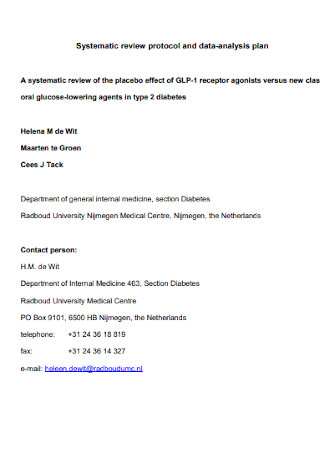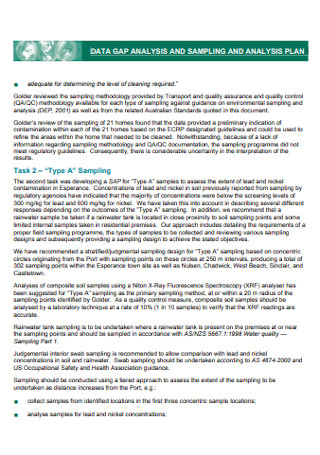12+ Sample Data Analysis Plans
-

Study Data Analysis Plan
download now -

Data Analysis Plan Format
download now -

Sample Data Analysis Plan
download now -

Simple Data Analysis Plan
download now -

Data Safety Analysis Plan
download now -

Quantitative Data Analysis Plan
download now -

GPS Data Analysis Plan
download now -

Data Interpretation Analysis Plan
download now -

Assessment and Data Analysis Plan
download now -

Systematic Rotocol and Data Analysis Plan
download now -

Data Gap Analysis Plan
download now -

Project Data Analysis Plan
download now -

Data Collection and Analysis Plan
download now
FREE Data Analysis Plan s to Download
12+ Sample Data Analysis Plans
What Is a Data Analysis Plans?
Benefits of Data Analysis Plan
Types of Data Analysis
How to Create a Data Analysis Report
FAQs
What does it mean to have data analysis skills?
Is Data Analytics a promising career path?
Is it necessary for data analysts to be mathematicians?
When it comes to data analysis and data analytics, what’s the difference?
What Is a Data Analysis Plans?
When you begin your data analysis plan, remind yourself of your goals. According to the latest data, 3% of Americans have written goals, and about 1% review and revise them regularly. As a result, the reasons why people don’t create plans have piqued my attention. A data analysis plan is a step-by-step guide for organizing and analyzing survey data forms. You’ll know what you’re going to do when you sit down to analyze the data you’ve acquired if you have a data analysis plan. You must have one because it’ll determine how you’ll collect your data. After all, it’s tough to introduce new variables later. As a result, you’ll want to make sure you’ve planned ahead of time so you can be sure you’re asking all of the right questions and know what you’re going to do. Sure, a plan only lasts until the first shot is fired, as the saying goes. That holds in data analysis as well. Having a decent strategy can save you a lot of time, whereas having a terrible one means you’ll be straining to make sense of the data at best, and at worst, you’ll realize your data is useless because you neglected to gather a critical variable.
Benefits of Data Analysis Plan
Data analysts offer numbers and figures to management in a data analysis plan, an internal arrangement function. It entails a more thorough approach to recording, analyzing, disseminating, and presenting data findings in a way that is easy to learn and use in business decisions. You will be able to make decisions on customer trends and behavior prediction, increase business profitability, and promote better decision-making using data analysis. You will be able to assess the reasons for certain occurrences based on data, grasp the aims and directives for your organization, and have technical insights into the business using easy-to-understand language after implementing a data analysis plan in your company. Moving forward, here are some of its benefits:
Types of Data Analysis
Users can utilize data analysis tools to process and alter data, examine linkages and correlations between data sets, and uncover patterns and trends that can be interpreted. The following is a comprehensive list of data analysis tools used in research. Based on business and technology, there are different sorts of data analysis approaches. However, the following are the most used Data Analysis techniques:
1. Prescriptive Analysis
Prescriptive Analysis utilizes the knowledge gained from prior analyses to determine the best course of action in a given situation or choice. Most data-driven businesses use prescriptive analysis because the predictive and descriptive analysis is insufficient to improve data performance. They examine data and make conclusions based on current events and problems.
2. Predictive Analysis
Predictive Analysis uses historical data to show “what is likely to happen.” The most basic data analysis example is if I bought two dresses last year with my funds and if my pay doubles this year, I can buy four dresses. But, of course, it’s not that simple because you have to consider other factors such as the possibility that clothing prices will rise this year, or that you will want to buy a new bike instead of dresses, or that you will need to buy a house! As a result, based on current or historical facts, this Analysis offers predictions regarding future events. Forecasting is nothing more than a guess. Its precision is determined by the amount of comprehensive information you have and how far you delve into it.
3. Diagnostic Analysis
Diagnostic Analysis answers the question, “Why did that happen?” by determining the cause using the information gleaned by Statistical Analysis. This Analysis helps identify behavioral data trends. If a new problem arises in your business process, you may use this Analysis to look for patterns comparable to that problem. It may also be able to apply similar prescriptions to new conditions.
4. Statistical Analysis
Statistical analysis elucidates “What happened?” through the use of historical data in the form of dashboards. Statistical analysis is the process of gathering, analyzing, interpreting, presenting, and modeling data. It performs an analysis on a set of data or a subset of data. This type of analysis is classified into two categories: descriptive analysis and inferential analysis.
5. Text Analysis
The term “Text Analysis” is also used interchangeably with “Data Mining.” It is a type of data analysis that utilizes databases or data mining tools to discover patterns in large data sets. It was previously used to convert raw data to business information. In the market, business intelligence tools are available that are used to make strategic business decisions. In general, it provides a method for extracting and examining data, deriving patterns, and finally, interpreting the data.
6. Exploratory Analysis
The exploratory analysis’s principal goal is to explore, as the name implies. There is still no understanding of the relationship between the data and the factors before it. After you’ve looked into the data, you can use exploratory analysis to make connections and develop hypotheses and solutions to specific problems. Data mining is a typical application for exploratory analysis.
How to Create a Data Analysis Report
Every data project list necessitates the presentation of findings in a readable data analysis report. This is a challenging exercise for some. After all, the primary purpose of a technical report is to convey information. If the material were simple to understand, however, it would be unlikely to require lengthy inquiry. It’s simple to see why even the most seasoned business executives find reporting scary in these circumstances. However, reporting, like any other skill, improves with practice. Five ways for improving writing data analysis reports are discussed below.
Step 1: Set a good example.
Every professional has access to a wealth of information regarding technical writing. For example, look for and download examples online. Examine these example reports with a critical eye to see who the target audience is, what message they’re attempting to convey, and which reports are the most successful. Businesspeople can use this information to improve their report writing skills in the future.
Step 2: Accept criticism.
No one is without flaws. As a result, learning to tolerate criticism is critical. Even if the individual reviewing the report is unfamiliar with technical processes, it is essential to include their opinion on the client or management. It’s also crucial to offer constructive criticism of your own, considering a writer’s structure and format rationale.
Step 3: Recognize the content.
When writing a data analysis report, it’s often preferable to start with the most detailed information. The most valuable words, for example, begin by discussing the remodeling contract, analysis, and graphing in which the author was intimately involved. This is because this is the most exact and thorough information available. The author will be familiar with the data sources, challenges encountered during analysis, outlier handling, and how irrelevant results were managed.
Step 4: Know your audience.
It is critical to comprehend the aim of a data analysis report before producing one. Some readers, for example, will utilize the intelligence to build strategy, while others will learn new things, yet others will seek to evaluate the data. In any case, the author should think about how the audience will react to the report. They should, in turn, customize the information to the appropriate audience by utilizing the proper tone and establishing common ground.
Step 5: Create a flexible plan.
When organizing complex information, it is critical to developing a solid outline. However, it is essential to avoid becoming a slave to a structure. It is crucial to structure a new statement naturally as it emerges during the writing process. Additionally, when creating an outline, ensure that the sections are balanced. This makes the content more readable, allowing the information to be absorbed more effectively. Additionally, weighting subsections according to their value is a beneficial technique. This will aid the reader in determining what information is critical and what is not.
FAQs
What does it mean to have data analysis skills?
A data analyst analyzes data and reports findings using technical skills. A data analyst might utilize SQL skills to collect data from a company database, then use programming abilities to analyze that data before reporting their findings to a larger audience on a typical day.
Is Data Analytics a promising career path?
There’s never been a better moment to learn data analytics and become a data scientist in the workforce. The job market is looking up, with chances spanning different industries and the nature of the job allowing for remote work flexibility and even self-employment.
Is it necessary for data analysts to be mathematicians?
You’ll need a strong knowledge of mathematics and the ability to combine figures to create new measurements reliably. A data analyst should also be familiar with statistics and formulas to meet basic commercial needs like compound interest or depreciation.
When it comes to data analysis and data analytics, what’s the difference?
Data analysis evaluates data using analytical and logical reasoning to arrive at an outcome or conclusion within a specified context. It is a multifaceted process that involves several steps, approaches, and diverse techniques. The method you take to data analysis is heavily influenced by the data available for research plans and the analysis’s purpose. Data analytics is a broad science or discipline that encompasses all aspects of data management. This includes breakdown and data collection, organization, and all the tools and techniques. Also, it’s the role of the data analyst to collect, analyze, and translate data into information that’s accessible. By identifying trends and patterns, analysts help organizations make better business decisions. Their capacity to describe, predict, and have performance improvement that increases their global and cross-industry demand.
When done correctly, there are virtually no limits to the possibilities of data analysis. Whether quantitative or qualitative, there are various analytical approaches and pathways for extracting meaningful insights from your data. Conducting data analysis on unstructured data can provide significant benefits and potential advancements for your business, regardless of whether the data originated from surveys, social media, or customer service tickets – the list goes on and on. There is a means of information that can be gleaned from data that you may have overlooked. With this, statistics show that 85 percent of businesses adopt big data and analytics technologies, with 96 percent planned or likely to hire new permanent data analytics staff.
